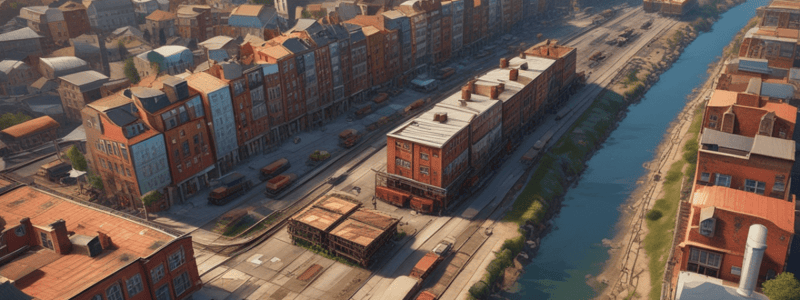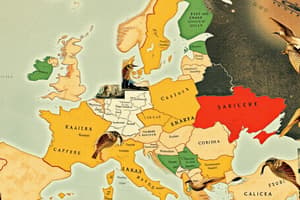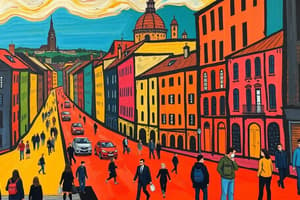Podcast
Questions and Answers
What is the primary factor that drives urbanization in Europe?
What is the primary factor that drives urbanization in Europe?
- Increased access to healthcare
- Expansion of the agricultural sector
- Improved transportation infrastructure
- Migration from rural to urban areas for employment opportunities (correct)
Which of the following best describes the impact of the Industrial Revolution on Europe?
Which of the following best describes the impact of the Industrial Revolution on Europe?
- It resulted in the mechanization of agricultural production.
- It led to the decline of handicraft-based industries.
- It caused a decrease in the proportion of the population residing in urban areas.
- It led to the emergence of new industries such as textiles, iron and steel, and coal mining. (correct)
What is the primary characteristic of nationalism as described in the text?
What is the primary characteristic of nationalism as described in the text?
- A focus on the development of a global economy.
- A sense of pride and loyalty towards one's nation. (correct)
- A desire for international cooperation and integration.
- A focus on individual rights and freedoms.
Which country is specifically mentioned as an example of industrialization in Europe during the Industrial Revolution?
Which country is specifically mentioned as an example of industrialization in Europe during the Industrial Revolution?
Which of the following is NOT a key characteristic of urbanization as described in the text?
Which of the following is NOT a key characteristic of urbanization as described in the text?
Which of the following is an example of a city that emerged during the Industrial Revolution in Europe?
Which of the following is an example of a city that emerged during the Industrial Revolution in Europe?
Which of the following is an example of nationalism in 19th century Europe?
Which of the following is an example of nationalism in 19th century Europe?
What is the primary characteristic of imperialism?
What is the primary characteristic of imperialism?
What is the advantage of specialized labor?
What is the advantage of specialized labor?
What is the primary function of a harbor?
What is the primary function of a harbor?
Which of the following is an example of a prominent mountain range in Europe?
Which of the following is an example of a prominent mountain range in Europe?
What is a characteristic of flat terrain?
What is a characteristic of flat terrain?
Which of the following is NOT an element of culture?
Which of the following is NOT an element of culture?
What defines an ethnic group?
What defines an ethnic group?
Which of the following is an example of European cultural heritage?
Which of the following is an example of European cultural heritage?
What is the significance of the North European Plain in Europe?
What is the significance of the North European Plain in Europe?
Flashcards are hidden until you start studying
Study Notes
Nationalism in Europe
- 19th century witnessed the rise of nationalism in Europe, with movements for Italian and German unification seeking to create unified nation-states out of fragmented territories.
- Giuseppe Garibaldi led the unification of Italy, while Otto von Bismarck unified Germany.
Imperialism
- Imperialism is the policy of extending a nation's authority and influence through territorial acquisition, economic domination, or cultural hegemony over other nations or territories.
- European powers engaged in imperialism during the late 19th and early 20th centuries, colonizing vast territories in Africa, Asia, and the Americas.
- The British Empire controlled colonies in India, Africa, and the Caribbean, while France colonized parts of Africa and Southeast Asia.
Specialized Labor
- Specialized labor refers to the division of labor in which individuals or groups focus on specific tasks or roles within an economy or production process.
- During the Industrial Revolution, European societies experienced a shift towards specialized labor, with workers concentrating on particular tasks within factories or industries.
- In textile mills, workers might specialize in spinning, weaving, or operating machinery.
Harbors
- A harbor is a sheltered body of water where ships can dock for loading, unloading, or shelter from storms.
- Harbors play a crucial role in maritime trade and transportation.
- The Port of Rotterdam in the Netherlands is one of the largest and busiest ports in the world, facilitating trade between Europe and other regions.
Mountains
- A mountain is a large landform that rises prominently above its surroundings, typically with steep slopes and considerable elevation.
- Mountains have significant ecological, geological, and cultural importance.
- The Alps, located in Central Europe, are one of the continent's most prominent mountain ranges, spanning several countries including France, Switzerland, Italy, and Austria.
- The Alps have shaped the region's geography, climate, and culture, and they attract millions of tourists each year for activities such as skiing, hiking, and mountaineering.
Flat Terrain
- Flat terrain refers to land with minimal variation in elevation, characterized by plains, plateaus, or lowlands.
- Flat terrain is often conducive to agriculture, transportation, and urban development.
- The North European Plain, stretching across countries such as Germany, Poland, and the Netherlands, is an example of flat terrain in Europe.
- Its fertile soils and relatively flat topography have made it a vital agricultural region and a hub for transportation and urbanization.
Culture
- Culture encompasses the beliefs, customs, arts, social institutions, and behaviors characteristic of a particular society or group of people.
- European culture is renowned for its rich cultural heritage, comprising diverse traditions and influences from various historical periods and regions.
- European culture encompasses classical art and architecture from ancient civilizations, as well as contributions to philosophy, literature, and music from figures like Plato, Shakespeare, and Beethoven.
Ethnic Groups
- Ethnic groups are social groups defined by shared cultural characteristics, such as language, religion, ancestry, and customs.
- Members of ethnic groups often identify with a common heritage and sense of identity.
- Europe is home to a wide array of ethnic groups, including the French, Germans, Italians, Spaniards, and many others.
Urbanization and Industrialization
- Urbanization refers to the process by which an increasing proportion of a population resides in urban areas, leading to the growth and development of cities.
- The Industrial Revolution in the 18th and 19th centuries led to significant urbanization in Europe, with the emergence of industrial cities such as Manchester in England and Essen in Germany.
- Industrialization is the transformation of an economy from primarily agrarian and handicraft-based to one dominated by industry and manufacturing.
- The Industrial Revolution, which originated in Europe, marked a period of rapid industrialization in countries like England, Germany, and France, where advancements in technology and infrastructure spurred the growth of industries such as textiles, iron and steel, and coal mining.
Studying That Suits You
Use AI to generate personalized quizzes and flashcards to suit your learning preferences.




